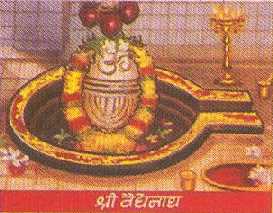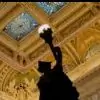
Ekambaranathar Temple or Ekambareswarar Temple is one of the largest temple in India, dedicated to Shiva , located in Kanchipuram in the state of TamilNadu, India. It is one of the five major Shiva temples or Pancha Bootha Sthalams (each representing a natural element) Here representing the element - Earth. The other four temples in this category are Thiruvanaikaval Jambhukeshwar(water), Chidambaram Natarajar (Sky), Thiruvanamalai Arunachaleshwara(fire) ,Sree Kalahasthi(wind). It is one of the 275 Saivate Paadal petra sthalam (Sung by Saivate saints called Nayanmars.)
Story of the Temple
As i have mentioned the story as a hint in my previous post containing information about Arunachaleshwar temple, Once, Lord Siva's wife Goddess Umadevi playfully closed His eyes which plunged the world into darkness. All living beings suffered in the dark. To absolve herse of this sin Mother Umadevi in name of "Kamakshi" created a Sivalingam out of sand and worshipped at Kancheepuram under a Mango tree near River Vegavathi.In order to test her devotion Shiva sent fire on her. Goddess Parvati prayed to her brother, Vishnu, for help. In order to save her, he took the Moon from Shiva's head and showed the rays which then cooled down the tree as well as Parvati. Shiva again sent the river Ganga (Ganges) to disrupt Parvati's penance. Parvati prayed to Ganga and convinced her that both of them were sisters and so should not harm her. Subsequently, Ganga did not disturb her penance and Parvati made a Shiva Linga out of sand to get united with Shiva. The God here came to be known as Ekambareswarar or "Lord of Mango Tree".
According to another legend, it is believed that Parvati worshipped Shiva in the form of a Prithivi Lingam (or a Lingam improvised out of sand), under a mango tree. Legend has it that the neighboring Vegavati river overflowed and threatened to engulf the Shiva Lingam and that Parvati as Kamakshi embraced the Lingam. Shiva touched by the gesture materialized in person and married her. In this context he is referred to as Tazhuva kuzhainthaar ("He who melted in Her embrace") in Tamil.Hence when she insist him to give the Left half of him,Lord directed her to do further penance in the Foot hills of Thiruvannamali .
It is said that two separate temples(Because In thiruvannamali only they represents as Ardanareshwar roop) erected after this incident for Lord Shiva as Ekambareswarar and Goddess Kamakshi(Name of Parvati devi ) adjacently in Kanchipuram. The Temples are Constructed by Great Pallava Kings belongs to 6 Cent A.D .The mango tree under which Kamakshi installed Shiv linga is believed to be still there in this temple complex, which is believed to be 3000 years to 3500 years old. This mango tree is the sthala vruksham of this temple. The mango tree is said to bear fruits of four different tastes each season, representing four Vedas of Hinduism. You can find the small shrine with the idols of Kamakshi and Shiv linga under the mango tree.(since the Old tree is dead before 6 years,to all devotee's surprise, after few days, from one of the branches of that old tree new green leaves begin to emerge and that is what now visible there.I myself Witnessed the old tree of 3500 years old before 6 years when it is alive, During our Pilgrim trip. )
[YOUTUBE]http://www.youtube.com/watch?feature=player_detailpage&v=FytcsluAiXU[/YOUTUBE]
[YOUTUBE]http://www.youtube.com/watch?v=GWALPfCb7dE&feature=player_detailpage[/YOUTUBE]
[YOUTUBE]http://www.youtube.com/watch?feature=player_detailpage&v=IK0MFApDdO0[/YOUTUBE]
The main deity of the temple is Lord Shiva, who is called as Ekambareswarar or Ekambaranathar in this temple. The deity is made up of sand and also called as Prithvi Linga. A Somaskanda panel featuring Shiva, Parvati and Skanda adorns the rear of the main shrine. There are other deities in this temple such as Vellakambar(name of Linga) worshipped by Brahma, Kallakambar(name of Linga they worshipped) by Vishnu and Nallakambar by Rudra. There are also idols such as Vikata chakra Vinayakar, Arumugar, 1008 lingas, 108 lingas, 63 nayanmars, Markendeyar, Bikshadanar, Nataraja, Pralayam katha ammai and Navagrahas. There is an idol of Lord Ganesha on peacock near the temple tower which is rare.Ekambaranathar temple has another highlight too. To the north east of Ekambareswarar shrine within the inner prakara (roundabout) of the Ekambareswarar temple, there is a Vishnu shrine. Lord Vishnu is called as Nilatingal Tunda Perumal here. The idol is in standing posture, and this shrine is one of the 108 famous Vishnu shrines (Divya Desams(temples associated with Vishnu)). As per the legend, Shiva wanted to test Paravti's commitment in performing pooja by setting fire to the mango tree under which she was seated. Parvati prayed to her brother Lord Vishnu, who caused waves of nectar to cool down the scorching rays. Lord Vishnu continues to stay here at the behest of Parvati. It is also said that, at the time of churning of Milky ocean to get nectar, Vishnu became warm and to cool himself, he requested Shiva to alleviate the discomfort through the cool rays of the moon adorning Shiva's head. Hence he got the name Nilaa-tingal tundattan.
The temple covers an area of over 23 acres (93,000 m2). Reaching a height of 59 meters, the temple's Raja Gopuram (the entrance tower to the temple) is one of the tallest in South India. One notable feature of the temple is the Aayiram Kaal Mandapam, or the "hallway with a thousand pillars", which was built by the Vijayanagar Kings.The temple's inner walls are decorated with an array of 1,008 Siva Lingams. The campus is 25 acres with 5 prakarams (or court yards) and has a thousand pillared hall. Kampai Tirtha, the temple tank is believed to have an underground holy river. The fourth court yard contains a small Ganesha temple and a pond. The third court yard contains lot of smaller shrines. The sanctum sanctorum contains the Lingam along with the image of Shiva
Kanchi Kamakshi Amman Temple
Pushpeshu Jhati : Purusheshu Vishnu: Naarishu Ramba: Nagareshu Kanchi: (said by Kalidasa)
The Goddess Kamakshi prevails in the form of Shakti. There are 51 Shakti Peetas across the country. The goddess residing place in Kanchi is called as "Nabisthana Ottiyana Peetam". The Goddess is called as "Sri Kamakshi. The word is derived from the heritage "Ka" means Goddess Saraswati (God of Education), "Ma" means Goddess Lakshmi (God of Wealth), "Akshi" means Eye. The name as a whole refers as the god lives in Kanchi with Goddess Saraswati and Goddess Lakshmi as her both eyes. The Lalitha Sahasranama poem is an idle example for the goddess power.
"Sachamara Ramavani Savya Dakshina Sevitha"
Kanchi is also called as Satyavrita Kshetra . The Goddess worshipped Lord Siva by creating a mud idol in Kanchi. At that moment, Lord Siva incarnated as Kamba River with high tides to test the worship of the goddess, the goddess grasped the idol closely with her two hands from eroding in the tides. This prevented the idol from getting eroded in the floods. The goddess also performed Pooja by sitting in a needle tip surrounded by "Panchakagni" (surrounded by 5 fires) to free herself from the interest of livelihood. The Lord Shiva became happy, gestured before her and married the goddess. Though there are many Shiva temples in the city, the only temple to have the sanctorum of the goddess is 'SRI KAMAKSHI AMMAN TEMPLE'. There are also eight other Shakti goddesses surrounding the temple.
The place where goddess resides is "Gayatri Mandapam". The Goddess lives in temple in 3 forms. They are Sri Kamakshi, Sri Bilahasam and Sri Chakram. The goddess is in a sitting posture of "Padmasana" .The goddess contains Pasa, Angusa, Pushpabana and Sugarcane in her forehands.
The Goddess Mahalakshmi was given curse by the Lord Vishnu to incarnate as Aarupam form. The Goddess Mahalakshmi comes to Kanchipuram and performs the worship chanting in the name of Lord Vishnu to free her from this Aarupam. After long prayers, the Goddess is freed from her Aarupam and given a Rupam by the Lord Vishnu. There exists a belief that Goddess kamakshi kumkum has to be offered to the idol of Aarupa Lakshmi within the sanctorum where by the goddess Lakshmi will fulfil your needs on the prayer.
The temple sanctorum consists of a deity "Adivaraha Perumal" which is one of the 108 Vaishnaivaite deity worship temple.
The history reveals us that King Dasaratha performed "Putra Kameshi Yagam" in the temple for the Birth of a child to his kingdom. The King performed pooja to the "Nabisthanam" of the goddess in the temple. The King Dasaratha within a few months received a child. The King Dasasratha belongs to the "Ekshuvagu Vamsam" where by the prime deity is Goddess Kamakshi. The extract of this story is visible in "Markendeya Puranam". The faith is if prayed truly the goddess provides child for the childless couples.
The Saint Adisankara born at Kaladi in Kerala travelled across all the parts of the country. When he visited Kanchipuram he felt the goddess is in a ferocious mode that the entire sanctorum was very hot. So to personify her and accomplish to her to normal state the saint sung songs in the praise of goddess named "Soundarya Lahari" then he established a Sri Chakra in front of her idol to keep her cool and personified. This srichakram is visible to all of us and all the poojas are done to srichakram too. The Saint established Sri Kanchi Kamakoti Peetam and attained Sarvagyna peetam in this holy city.
[YOUTUBE]http://www.youtube.com/watch?feature=player_detailpage&v=LM9lUutFtb4[/YOUTUBE]
The temple was visited by a dumb devotee named "Mookan". The devotee begged the goddess to free him from this dumbness so that he can perform poems on the praise of the goddess. The goddess suddenly provides him grace by freeing him from dumbness and giving him intellectuality in creating poetry. He was very happy with the goddess that he wrote a poetry named "Mookapanchashati" in which he praises entirely about the grace of the goddess with her beauty.
The temple goddess has been so graceful that she has made dumb to a poetist, has given birth to the childless couples and provides wealth to all her devotees. The goddess destroys evil and helps the prosperity of goodness to prosper throughout the world.
It is said that the Meenakshi Amman temple in Madurai, the Akilandeswari temple in Thiruvanaikaval near Tiruchirappalli and this Kamakshi are the important centers of worship of Parvati as the mother goddess, in the state of Tamil Nadu.The temple was most probably built by the Pallava kings, whose capital was Kanchipuram, around 6 C.E.
The main deity, Kamakshi, is seated in a majestic Padmasana, an Yogic posture signifying peace and prosperity, instead of the traditional standing pose. The goddess holds a sugarcane bow and bunch of flowers in the lower two of her arms and has a pasha (lasso), an ankusha (goad) in her upper two arms. There is also a parrot perched near the flower bunch. There are no other Parvati temples in the city of Kanchipuram, apart from this temple, which is unusual in a traditional city that has hundreds of traditional temples.
The special occasions for the Goddess Kamakshi are Navratri, Bhramotsavam and Pournami (Full Moon Day). The goddess is distinctively powerful in these times and it is even more auspicious to visit the temple in these days.
Completed....
My next post will on Thiruvanaikaval Jambhukeshwar (water),Hence by my next update the Pancha bootha sthala's are going to be finished ..pg 12









































